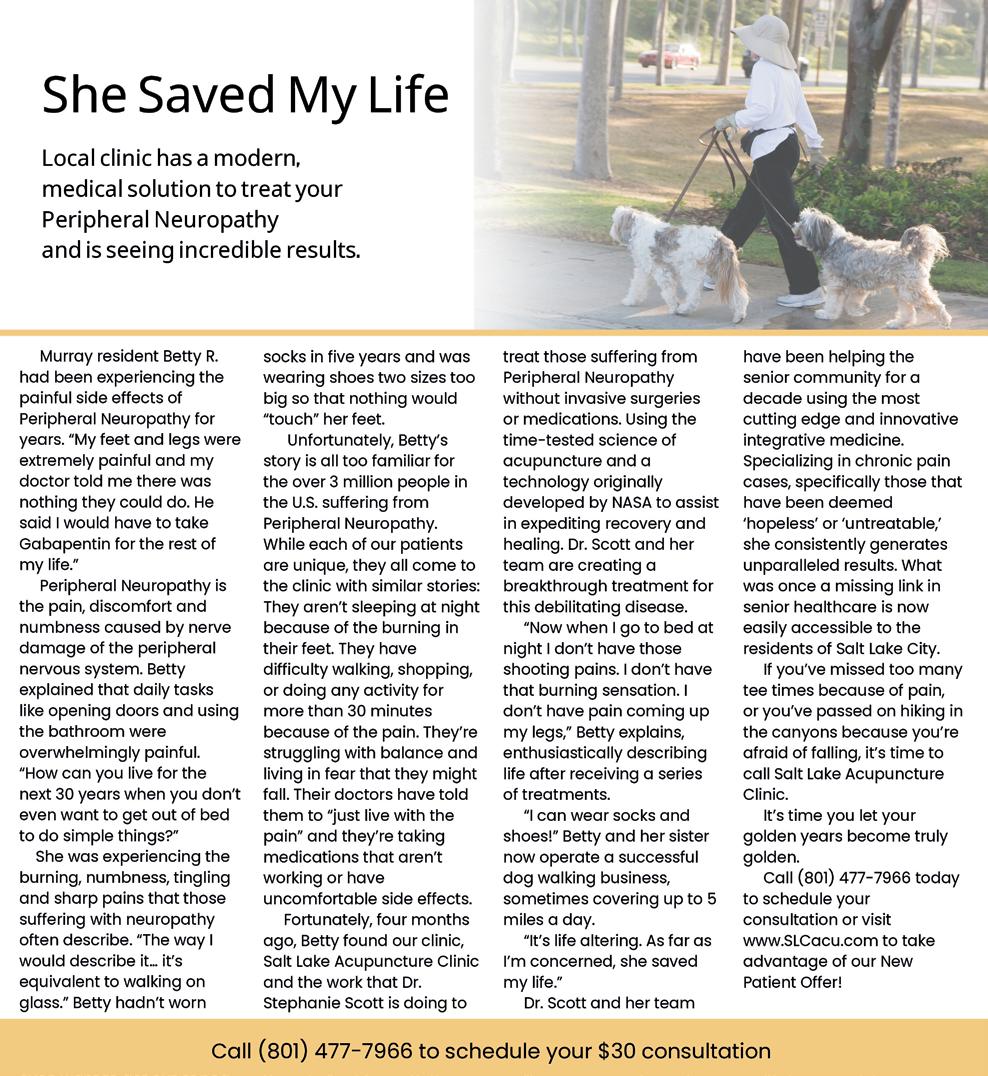

Churchill Jr. High marks 60th year with food, fun and family
By Lizzie Walje | l.walje@mycityjournals.com
Churchill Jr. High turned 60 years old. To celebrate, the school hosted a 1960’s groovy-themed party, where students celebrated alongside friends, family, alumni and community members.
Churchill Jr. High School has officially entered its sixth decade in operation. To celebrate this major milestone, the school threw a groovy 60’s themed event, where students, faculty, alumni, families and community members were invited to enjoy an evening full of memorabilia, food, fun and music.
Granite School District, of which Churchill is a part of, has changed significantly over the years. Like many districts, it has endured its fair share of closures, renovations and boundary shifts. Through all of these changes, Churchill has persevered, serving thousands of students over the course of its tenure.
Churchill first opened its doors in 1965, a year that was defined by counterculture movements, civil rights protests and the Vietnam War. For many of Churchill’s oldest alumni, it’s almost impossible to reconcile.
“In some ways it feels like just yesterday and in others, well, I can hardly believe it,” said Steve Allen, a Churchill alum, who attended the school in the late ’60s following

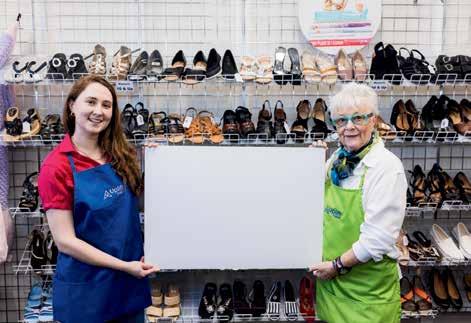



Part of the festivities featured live musical performances, most notably from current Churchill students. (Granite School District)






























MEET DR. HARARAH, M.D.
Dr. Hararah, a triple board-certified physician, completed his residency in Family Medicine at NYU Langone and a fellowship in Undersea and Hyperbaric Medicine/Wound Care at SUNY Upstate University Hospital. With additional training in Bariatric Medicine and certification from the American Board of Obesity Medicine, he brings expertise in primary care, dive medicine, bariatric medicine, and clinical hyperbarics.
A firm believer in the biopsychosocial approach, Dr. Hararah views patients as complex individuals whose lives and experiences shape their healthcare. Known for his compassionate care and dedication, he listens intently, prioritizes your well-being, and works to find the best diagnosis and treatment plan.
As the owner of Blackstone Medical, Dr. Hararah is committed to helping you achieve your best health.
OUR SERVICES
Primary Care:
• Annual preventative physical exams
• Cancer screening
• Sick visits
• Specialist referrals
• Medication refills
• Chronic disease management
Specializing in Wound Care:
• Chronic, non-healing wounds
• Acute, minor wounds
• Diabetic foot ulcers
• Venous ulcers
• Arterial ulcers
• Pressure injuries...and more!
Patients First:
“Dr. Hararah understands the daunting and sometimes demoralizing feelings health care sometimes causes, and wants patients to be truly seen and valued as human beings.”

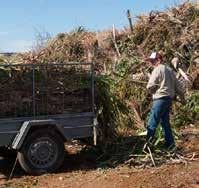

its opening. “What gets me is looking at it now, seeing its age. We were some of the first students to ever learn here and, at the time, it was brand new. I remember feeling so special, so excited to be in this brandnew place. And here it is 60 years later, not so new anymore.”
Allen grew up in the Olympus Cove neighborhood, where Churchill Jr. High is located at 3450 E. Oakview Drive.
Perched above Wasatch Boulevard and Interstate 215, Churchill offers sweeping views of the Salt Lake Valley. Its soccer
field was the perfect backdrop for its 60year celebration.
To kick off the festivities, Churchill dug into its archives, producing all sorts of memorabilia from yearbooks to class jackets. Alumni and students took to the cafeteria where they looked through yearbooks, sharing memories of decades passed. Photographs were on display, organized by decade, highlighting the many achievements of Churchill and its students.
With the school motto of “Learners today; leaders tomorrow” Churchill’s values are anchored in a tradition of achievement. Through the decades Churchill has
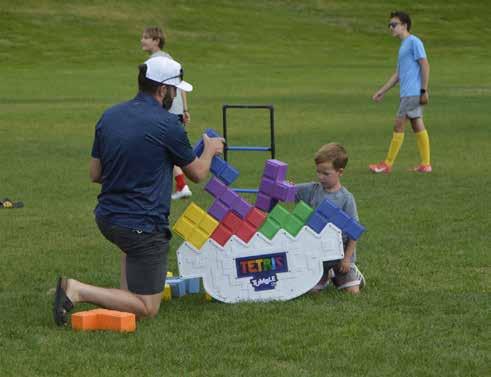
sought to prepare its students for success. Some notable achievements have come in the form of high rankings in sports, top competition placements in band and orchestra, and various recognitions at the faculty level.
“Students that attend here are highly motivated and involved from everything such as being Olympic hopefuls to participating in local music and dance ensembles to being recognized for their community service,” the school says per its mission statement.
The evening’s main event played out with a party on the school’s soc-
cer field. Attendees were treated to food trucks, games, family-friendly fun, and live musical performances from past and present students, showcasing generations of Churchill Jr. High School talent.
The event concluded as the sun set.
“Thank you to everyone who joined us to celebrate 60 years of Churchill Jr. High!” stated Granite School District’s Facebook page. “From food trucks and live performances to flipping through decades of yearbooks, it was a night full of memories, laughter and community spirit.” l

MILLCREEK TEAM
The Millcreek Journal is a monthly publication distributed directly to residents via the USPS as well as locations throughout Millcreek.
For information about distribution please email hello@thecityjournals.com or call our offices. Rack locations are also available on our website.
The views and opinions expressed in display advertisements do not necessarily reflect or represent the views and opinions held by Loyal Perch Media or the City Journals. This publication may not be reproduced in whole or in part without the express written consent of the owner. © 2019 Loyal Perch Media, Inc.
PUBLISHER
Bryan Scott | bryan.s@thecityjournals.com
EDITOR
Travis Barton | travis.b@thecityjournals.com
ADVERTISING EXECUTIVES
Mieka Sawatzki | mieka.s@thecityjournals.com
Lindsay Andreasen | lindsay.a@thecityjournals.com
Jason Corbridge | jason.c@thecityjournals.com
Ryan Casper | ryan.c@thecityjournals.com
Marc Davis | marc.d@thecityjournals.com CIRCULATION
Rack
Lydia Rice | lydia.r@thecityjournals.com 385-557-1022
Stacey LaMont Ty Gorton MILLCREEK
9500 South 500 West, Suite 205 Sandy, UT 84070
PHONE: 801-254-5974

Part of the festivities featured live musical performances, most notably from current Churchill students. (Granite School District)
Churchill turned their soccer field into a party zone with games, food trucks, live music and more. (Granite School District)
Treating your whole family tree.
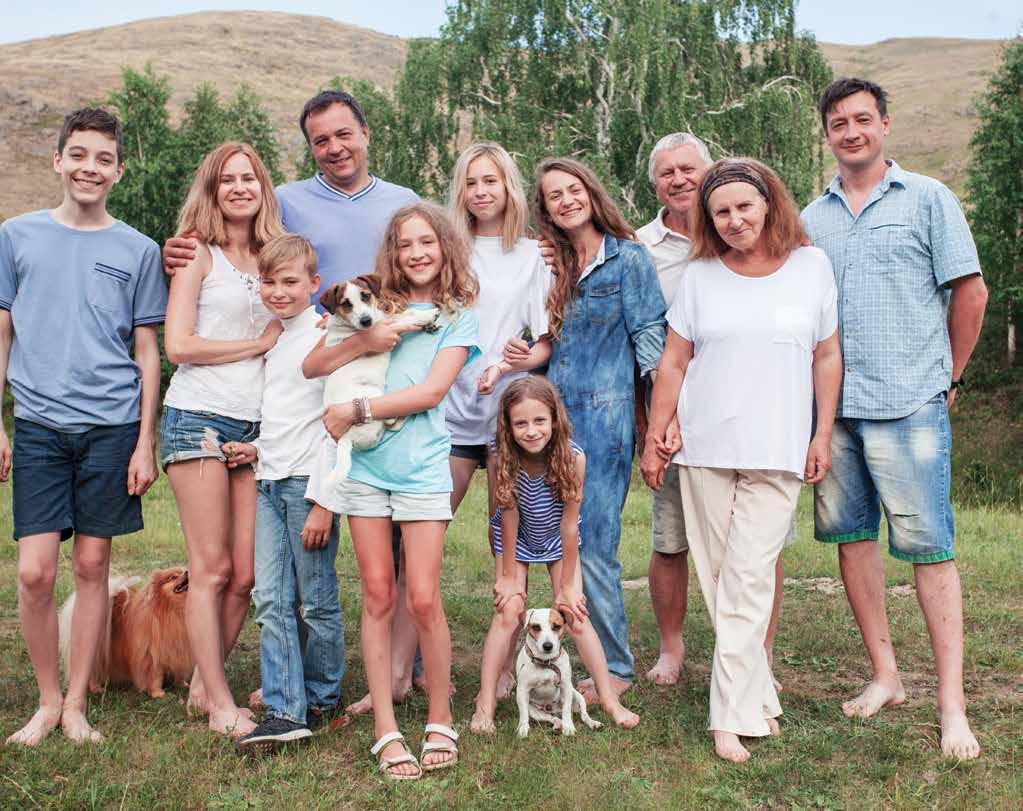
Holy Cross Hospitals have been trusted by Utah families since 1875.
For 150 years, Holy Cross Hospitals have cared for Utah families in their most tender, powerful, and vulnerable moments. From newborn checkups to post-op recoveries, we’ve seen generations through their highest highs and hardest days.
We’ve done it all with one purpose: to treat people, not just patients. We care for every person with personalized treatment powered by compassion and respect.
Our belief that we all hold the power to heal helps us provide care that spans generations and stands the test of time.
Learn more at mountain.commonspirit.org/holycross150.
City celebrates Pacific Islander Skate Night at Millcreek Common
This year’s Pacific Islander Skate Night celebrated community, culture and continued Millcreek’s tradition of celebrating its diverse population.
By Jolene Croasmun
j.croasmun@mycityjournals.com
August in Utah is Pacific Islander Heritage month and Millcreek Common kicked off the celebration with a skate night, food, music, bounce house and real flower lei making classes.
“Millcreek has shown such great excitement in embracing all ethnicities in all communities. This is the third year we are doing this,” Analei Samasei’a said. Samasei’a is on the Millcreek planning committee.
On Aug. 1, Millcreek Common gave the first 1,000 folks free skating and rentals during the Pacific Islander Skate Night which was courtesy of Granite Credit Union, one of the sponsors.
Millcreek Councilmember Bev Uipi emceed Pacific Islander Skate Night with Big Budah. Uipi is a third generation Pacific Islander from Millcreek.
“I am the first Pacific Islander female elected to office here in Utah,” Uipi said. “In Millcreek we celebrate diversity, we have events celebrating our Latino community,
our Black community and we also celebrate the Pacific Islander community.”
Uipi’s parents moved to Millcreek in 1982 and her father, Filla “Phil” Uipi was in the House of Representatives in Utah. “It is important for kids and younger generations to see people that look like them and they say, ‘I can do this, if they can do it then I can do it too,’” Uipi said.
“It’s a fun event, everyone in the family can participate, even our elders. It is a blending of community,” Uipi said.
The celebrations included a bounce house for kids that promoted jump therapy. This was sponsored by Jump 4 Autism. Viliami Paipa is the founder who has personal experience with autism and wanted to include awareness of autism with the Pacific Islander festival. “At Jump 4 Autism we promote physical activity including jiu-jitsu, soccer and basketball. This is allowing better relationships with kids and parents,” Paipa said.
Music was provided by Robby Lee, who plays a ukulele and is from Hawaii. “I have 15 years of solo ukulele experience, and I build the music. So I start out with nothing then build my own harmonies, my own drums then I will sing for three hours for an event,” Lee said. “This is my first time performing at Millcreek Common.” Lee’s most requested song is “Somewhere

over the Rainbow/What a Wonderful World” by Israel Kamakawiwoʻole.
Touch of Polynesia provided food to set the mood for the Pacific Islander Skate night. “Our signature food is a Polynesian drink called Otai and it is fresh fruit. We sell mango pineapple Otai and we also have Polynesian doughnuts,” owner Paea Finau

said. They have been working festivals for over 20 years.
Families attended the skate night, with many enjoying the free skating and rentals provided. The atmosphere was filled with laughter and the joy of shared cultural experience. l

Re-Elect
Thom DeSirant
Millcreek City Council
Millcreek isn’t just where I live - it’s my home, and I’m committed to making it a place where families can thrive for generations to come. Since being elected to the City Council, I’ve focused on creating a stronger, more connected community by expanding open space, improving infrastructure, and ensuring responsible growth that prioritizes homeownership. I’m proud of what we’ve accomplished together, but there’s still more work to do. I’m running for reelection to keep Millcreek a great place to call home.

Touch of Polynesia food truck with owner Paea Finau and daughter Alai at Millcreek Common in August. (Jolene Croasmun/City Journals)
Millcreek Council hears about black flies, after-school program budgets
Council hears presentation about a tax increase proposal to support the Mosquito Abatement District and discusses allocating after-school program funding.
By Alexandra Straumann a.straumann@mycityjournals.com
OnAug. 11, the Millcreek City Council discussed agenda items that will be continuing to develop over the coming weeks. As Mayor Jeff Silvestrini was not present, Councilmember Bev Uipi acted as Mayor Pro Tem for the evening.
Councilmember Silvia Catten started with presentation about a proposed tax increase to support the South Salt Lake Valley Mosquito Abatement District. Catten serves as the Chair of the Governing Board for this district and has been on the mosquito board for nine years. She explained that the tax increase would take the yearly fee (assessed through residential property taxes) from $2.96 to $3.95 a home, to support the reintegration of the program.
Catten explained that black flies live in canals, ditches and rivers. And while these flies may not pose a direct threat to humans, they cause ecological issues that hurt areas with farms, subsequently impacting the farm-
ers, farm animals and other kinds of wildlife. The funds raised via this tax would be used to increase utilization and spread awareness of black flies.
The black fly tax was initially raised in 2002 to support the program through the construction of new facilities and was lowered in 2012 after they felt it was no longer a justifiable increase. The new proposed tax would generate an overall revenue increase of approximately $320,000 a year. Catten explained that justification for the increase comes from the 200,000 new residents and 72,000 new homes added across the district and valley. A population increase like this makes it possible to raise significant funds with limited change to the taxpayer, and these new residents have provided the board with greater opportunity to optimize completing the goals of this program.
In regard to utilization, some of the goals Catten outlined in the program include cost stabilization while maintaining quality of service, upgrading data systems for response tracking, and expanding lab testing capabilities. Education would be a component of this as well, “adding more public relations and education gets people thinking about the way they live and how they approach mosquitos.”
City attorney John Brems noted that it is not a requirement for the city to send out a notice about the increase, and Uipi emphasized the need to communicate these decisions and
reasoning to the public. Catten had also echoed this sentiment during her presentation, acknowledging that while this “it doesn’t seem like a lot and it really isn’t,” they wanted to make sure that the general public understood the purpose of it and have the ability to chime in. On Dec. 8 at 6 p.m., there will be a public hearing to discuss the tax increase proposal and hear from the public at 7308 Airport Road in West Jordan.
Following this, the council continued a discussion about funding for after-school programs supported by the Asian Association of Utah, with representatives coming back to the
council to advocate for getting these funds. Kayla Meyers, the Promise Program manager, spoke briefly to the council to advocate for these funds in the wake of experiencing budget cuts.
Previously in July, the council heard the beginning of arguments to provide up to $110,000 to support the maintaining of after-school education programs. Due to funding cuts, the school is in need of the council’s monetary support. Ordinance 25-31 was opened to a public hearing, and after Councilmember Cheri Jackson moved to adopt the ordinance and the council passed it unanimously. l

Always Know Who’s Caring for Your Loved One
With Nanny4Granny, families in Salt Lake County have a trusted partner in Alzheimer’s and dementia care, as well as companion care. Founded by Denise Heiskell, a caregiver with decades of experience with children and the elderly, the in-home support service o ers companion care and CNA services tailored to each individual’s needs.
Nannies provide much needed companionship for your loved one whether it be listening to their favorite music, sharing stories, playing cards, making crafts, cookies and even light exercise of stretching and walking.
Denise said: “with Nanny4Granny, you’ll always know who’s caring for your loved one.
There’s no rotating sta , just one consistent, compassionate caregiver.” Founded in July 2025, Nanny4Granny is the new kid on the block, o ering full-time, parttime, overnight and in-home care.
What sets your company apart from your competitors?
There’s one nanny per elderly person. No random caregivers show up unexpectedly. My nannies are trained in Con ict Avoidance Techniques. We stress validation, redirection and compromise.
Who is your ideal client?
How do potential clients normally choose between you or a competitor?
Potential clients are inspired by my background as a care provider. I bring a personal touch to each situation. Clients and families have the opportunity to meet the nanny before deciding to move forward. We want to make sure we have the right person helping your loved one.
What is your favorite service your company o ers?
At Nanny4Granny, we build relationships between the family and the nanny that bring comfort to all parties. It’s a relief to know your loved one is being watched over by someone with kindness, empathy and compassion.

Our ideal client is any elderly person who needs loving attention in their home or who would like a “lunch buddy” while living in a facility. Our services help combat the loneliness epidemic experienced by seniors in the county.
What type of care do your nannies provide?
My nannies can tackle most household tasks, like cooking, cleaning, shopping and doing laundry. They also provide transportation to appointments or social events. Personal care is important, and our nannies o er bathing, dressing and grooming services. We’re also perfect for seniors experiencing loneliness or social isolation. We engage in conversation, take them on outings and engage them in social activities. We also watch for safety concerns or health changes.
What is your best advice for someone who is considering doing business with you?
I want people to give me a call, and I will schedule an in-home

consultation with the family. I will also spend time talking with the client in need so I can assess their needs and expectations.
Anything else you would like our readers to know about your business?
We have nannies available and ready to meet you. My nannies are well paid and are delighted to have the opportunity to build a warm and trusting relationship with the family. Working with my company could be the best decision you could make to help your elderly loved ones.
Tax increase information from Millcreek City Council live stream meeting presentation. (Millcreek City)
A look at the history of the Jordan River and the commission’s work on improving it.
By Alexandra Straumann a.straumann@mycityjournals.com
On Aug. 29, the Get To The River Festival kicked off at Porter’s Landing boat takeout in North Salt Lake. This event kickstarted the events put on by the festival, with over 50 opportunities for people to celebrate by the river. The theme of this year’s festival is “Our River, Our Future,” which is fitting, as this year marks the 15-year anniversary of the Jordan River Commission, an organization largely responsible for many of the remarkable upgrades to this riparian community.
Millcreek City Councilmember Silvia Catten first joined the commission to represent Millcreek in 2018 and has been serving as the chair of the Jordan River Commission Governing Board. During the Aug. 25 council meeting, she highlighted the successes of the committee over their 15 years. Millcreek Mayor Jeff Silvestrini applauded the efforts of Catten and the commission, acknowledging that
the idea of a trail like this “was a dream” until they made it reality.
While many residents use the Jordan River Parkway daily now, the system of trails would have once never seemed possible given the river’s condition or scale. The Jordan River extends for 51 miles flowing north. Its stream is comprised of seven major tributary systems and it drains water from Utah Lake into the Great Salt Lake.
The river was home to Indigenous people thousands of years ago who called it “Pia Okwai,” which in the Newe Taikwa language which means “big river” or “big flow.” The original name was fitting, as the river was over five times larger than it is today. But after Mormon pioneers arrived in the valley, they renamed it the Jordan River, a reference to the similar water pattern present in the River Jordan in the Middle East.
For many decades the river was neglected and was used as a dumping ground for waste. Industrial waste and garbage alike were commonly disposed of in the river until 1973 when the Utah State Legislature created the Provo-Jordan River Parkway Authority to improve river conditions.
Despite this, the river and its surrounding environment continued to be polluted and


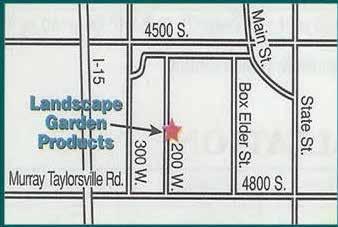





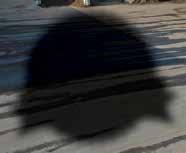





September held multiple Get to the River events. (Alexandra Straumann/City Journals)
experienced disruptions due to its falling water levels. As a result, between 2007 and 2008
Envision Utah worked with over 3,000 participants to create BluePrint Vision, a plan for revitalizing the surrounding area and watershed. A component of this was a temporary committee with representatives from each of the 18 jurisdictions along or affected by the river. The Blueprint Jordan River Implementation Committee facilitated the creation of the 2010 Interlocal Agreement, that formed the beginnings of the Jordan River Commission we see today.
Today, the commission works to make the Jordan River and its parkway places where people congregate and can enjoy wildlife right in the heart of their communities. The Interlocal Cooperation Agreement names seven goals the commission prioritizes its focus on, including developing recreation access, securing funding for acquisition of more critical habitat space, and promoting use of the river.
A highlight of their restoration project is the Jordan River Channel Repair Project at Winchester Street, which eliminated one of the most hazardous navigation barriers along the water. The project was completed in 2015, and has improved fish, plant and bird habitat by providing a stable channel for moving watercraft at any flow.
The river’s habitats are necessary to accommodate natural wildlife, but also serve as a critical resting site for migratory birds on their
way to Central America. The Big Bend Habitat Restoration Area in West Jordan is aiming to take on this issue, by restoring 70 acres of migratory bird and wildlife habitat through reconnecting the floodplain with the river. This can be done through the construction of a new meandering channel and wetlands, and upon its completion, a mile of river channel will be restored to support these animals, as well as urban fisheries, wetlands, riparian habitat and upland habitat. Additionally, this restoration will improve water quality by reducing the degree of sediment and organic matter being eroded by the river.
Improving the land for wildlife makes the land and water better for everybody, and part of Get To The River Fest is to teach the public about the ecosystems that surround them. The commission has worked to improve the community’s access to learning about the wildlife outside of the festival, and many of the new boat ramps, boardwalks and recreation areas are equipped with signs with facts about the wildlife and history of the river and surrounding areas.
In September there are Get To The River events on many days and will feature a variety of conservation, recreation, arts, social and educational experiences. Check out the calendar of scheduled events for the festival here, and learn more about the Jordan River Commission and its work to revitalize the river here.l
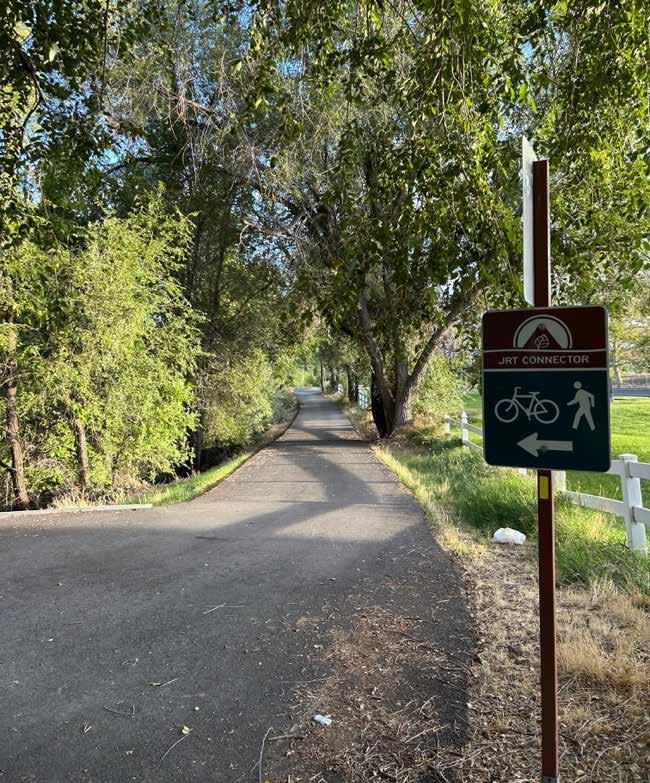

Jordan River Trail with a sign. (Alexandra Straumann/City Journals)
NEW AREA
New outdoor lighting standards adopted in Holladay
Amended code addresses light trespass and nuisance.

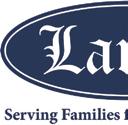


By Peri Kinder peri.k@mycityjournals.com
The Holladay City Council approved a new city code relating to residential outdoor lighting standards. In response to feedback and concern from residents, the mayor, council and city staff amended the code to address lighting trespass and nuisance lighting in new residential construction and major home remodeling projects.
Considered a form of light pollution, light trespass occurs when artificial light from one home spills over into a neighboring residence in a way that is disruptive. Nuisance lighting typically includes issues such as excessive glare, over-illumination, or light disruption that can interfere with sleep, the night sky or wildlife behavior.
While councilmembers understood the need for some lighting regulation, it was not their intent to limit creativity when it comes to residential outdoor lighting.
“We’re just addressing the specific problems, like trespass and where there’s nuisance,” said Councilmember Paul Fotheringham. “Otherwise, people can be as creative or have as much bad taste as they want. We’re not going to regulate that, but rather just deal with the problems that involve unfriendliness, or rather, inattention to the concerns of neighbors that changes the character of a street.”
After much deliberation, discussion and a public hearing, the council unanimously adopted the new standards into the city code on Aug. 7, which immediately put the changes into place.
Councilmembers didn’t want to pi-

geonhole property owners into strict guidelines and they didn’t want homeowners to be required to work with a lighting professional, which can add higher costs to building. At the same time, the council didn’t want to ignore the concerns of the residents.
“This was our compromise to see if we can put something in place that tries to accomplish the goal of what we think our residents want, but not have it be so stringent that it extends and makes the process of building a home more expensive,” said Mayor Rob Dahle. “But it does give our staff the tools to say, ‘Look, you need to make sure you comply here, here and here, out of respect for your neighbors in the community.’ So I think it landed in a good spot.”
The new code does not apply to indoor lighting; seasonal light displays (as long as it’s not considered a hazard or nuisance); temporary lighting for celebrations, events and festivals; temporary construction lighting; regulated signage; or traffic control warnings, signals and devices.
Some prohibited items include the encroachment of excessive light, laser lighting, searchlights and neon or fluorescent tubes.
“This ordinance consolidates all the existing lighting standards into one new chapter, which is now known as 13.84,” said Holladay Community and Economic Development Director Jon Teerlink. “Because the technology of lighting changes so often, having a strict set of provisions in the code holds property owners’ feet to the fire on specific lighting technology. As that technology changes, those new elements can be brought to the staff as a proposal.” l

Holladay City code was updated to include new requirements on residential construction to limit light trespass and nuisance. (Adobe stock)
Millcreek Council adopts ordinance to support victims of Willow Glen Apartments fire
The Millcreek City Council discussed more action to support the victims of the Willow Glen Apartments fire.
By Alexandra Straumann a.straumann@mycityjournals.com
OnAug. 25, the Millcreek City Council passed a resolution to increase the funding provided to the victims of the Willow Glen Apartments fire.
Just a month earlier, on July 25, a grass fire escalated and devastated the Willow Glen Apartments. Despite efforts from the Unified Fire Authority and over 100 responding officers, the fire displaced 79 residents and destroyed 24 apartment units.
The council has been discussing the fire and best practices to provide relief for those impacted. The damage was so extensive that displaced families were not able to return to their units to retrieve any surviving belongings. Mayor Jeff Silvestrini emphasized the devastation these people are experiencing to the council and attendees, remarking that those living in the impacted units “all lost everything.”
The councilmembers themselves expressed sorrow for the loss these families are
experiencing. Because of this, the council emphasized the need to provide monetary support for these families to start to rebuild.
To facilitate providing further relief, Silvestrini proposed Ordinance 25-33 to the council, which would allow for the financial contribution allocated to residents displaced by the fire to increase up to $11,500. In accordance with state law, a study was conducted by an independent third party to determine if spending city funds for said cause aligns with the broader community goals.
While the mayor acknowledged that there was no doubt these funds were being used for good, due to the emergency nature of the situation, this study was not done prior to the initial disbursement of funds. He emphasized the need to conduct the proper measures for the sake of the community, and the study concluded that allocating these funds for this purpose is in accordance with the best interests of the community. The council opened up the Ordinance to public comment to which there was none, and a motion to approve was set forward by Councilmember Thom DeSirant, and Councilmember Cheri Jackson. The council then voted unanimously to approve the allocation of funds.
The community rallying together in the wake of these events was praised by the council, and Jackson thanked the public and the volunteers for giving back to the com-
munity in this way, and she added that she was “glad we as a city were able to offer this support to residents” and the mayor agreed that the “magnitude of loss” made this a truly extraordinary event, “requiring an extraordinary response.”
Following this, the council considered Ordinance 25-34, which would allocate additional non-monetary services for those residents displaced by the fires. Immediately following the disaster, the Red Cross provided a temporary evacuation center for displaced residents, and in the following weeks there has been an outpouring of community support and fundraising. Thousands of dollars were raised to support these families, allowing for a sizeable increase in funds available to support them.
The ordinance was passed with no public comment.
In addition to the community support and the aid from the firefighters, the Unified Police Department responded to the fire by assisting in evacuations, accounting for residents and retrieving pets from apartments.
The Millcreek Precinct Chief Christine Petty-Brown recognized some of the responding officers for their efforts while fighting the fire, which received a standing ovation from the council. Some members of the Unified Fire Authority of Millcreek were also in attendance for the session and were







subsequently applauded by the council and mayor for their work in responding to the disaster. Many fire departments in the valley provided personnel to assist in responding to this fire, emphasizing the importance of community teamwork during a disaster. l
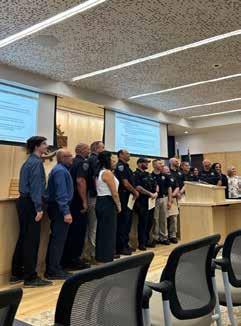





Millcreek councilmembers and Unified Police Department staff pose for a photo. (Alexandra Straumann/City Journals)
From costumes to candy: A safety checklist every family needs
Halloween Safety 101: The Essential Guide for Parents and Homeowners.
By Holly Curby hello@hollycurby.com
With Halloween right around the corner, families are busy planning costumes, buying candy and decorating their homes. But amidst the excitement, safety should be a top priority. This festive night—meant for costumes and candy—can quickly take a dangerous turn if precautions aren’t taken. According to safety experts Judy Chavez from the U.S. Consumer Product Safety Commission and Amy Bryant, Crime Prevention Specialist with Sandy City Police, Halloween is one of the riskiest nights of the year for children and families.
Here’s how you can enjoy the frightful fun without real scares.
Costume Safety: Keep it Fun and Flame-Free
“Costumes should fit properly—not too long, loose or baggy,” Chavez said. “Long, flowing fabric can lead to trips and falls or even become a fire hazard if it brushes up against open flames like in Jack-o’-lanterns.”
When choosing costumes:
• Opt for flame-resistant materials like polyester or nylon.
• Avoid sheer cotton or rayon, which are more flammable.
• Add reflective tape or glow sticks to ensure visibility at night.
• Use hypoallergenic makeup and remem-
ber to remove it before bedtime—especially for kids with sensitive skin.
Chavez added, “Costume safety isn’t just about fire. It’s about preventing falls, rashes and other injuries we see every Halloween.”
Home Security: Don’t Let the Wrong Goblin In
Bryant reminds homeowners that Halloween isn’t just busy for trick-or-treaters— criminals may be lurking, too. “Keep all doors and windows locked, whether you’re home or not,” Bryant said. “Don’t assume because it’s a family night that everyone has good intentions.”
Other tips:
• Don’t open the door to strangers if you’re not expecting them.
• Teach kids not to answer the door without an adult’s permission.
• Install deadbolt locks with a 1.5-inch throw for added security.
• Use long screws in strike plates for stronger resistance to forced entry.
And don’t forget the garage. “Garage doors left open are an open invitation,” Bryant said. “Close and lock them—and if you’re going out of town, unplug the garage opener entirely.”
Porch Pirates Beware: Protect Your Packages
Halloween kicks off the holiday season, which often includes more online shopping and deliveries. “Track your packages and get them off the porch as soon as they arrive,” Bryant said. “Porch pirates are waiting for a
chance to snatch them.”
Consider having packages delivered:
• To your workplace
• To a trusted neighbor
• To a secure community locker
Also, let trusted neighbors know if you’ll be out of town. “They can keep an eye on things, collect packages, and even roll out your trash bins to make it look like you’re home,” she added.
Trick-or-Treating: Safety on the Streets
Trick-or-treating is a highlight of Halloween—but it also poses risks, especially after dark.
Bryant emphasized: “An adult should always accompany children. Even if they think they’re old enough, parents need to be nearby.” According to Chavez, the CPSC estimates 3,600 Halloween-related injuries occurred in recent years, many due to falls, allergic reactions and decoration-related accidents.
To stay safe:
• Use sidewalks and crosswalks—never jaywalk.
• Make eye contact with drivers before crossing.
• Equip costumes with flashlights, glow sticks or reflective gear.
• Choose well-lit neighborhoods and avoid poorly lit areas.
“Motorists, too, need to do their part,” Bryant said. “Drive slowly, keep headlights on, and be extra cautious in residential areas.”
Don’t Let Decorations Become a Disaster
That adorable Jack-o’-lantern on your

porch? It might be a fire risk.
“If you use candles, never leave them unattended,” Chavez said. “Better yet, opt for battery-operated LED candles.”
Also:
• Bring in pumpkins and outdoor décor at the end of the night.
• Avoid leaving anything out that can be vandalized or used dangerously.
• Monitor any electrical decorations for exposed wires or overloading outlets.
Have Fun, Stay Safe
Halloween is meant to be fun—not hazardous. With the right precautions, families can enjoy the thrills of the season without becoming part of the injury statistics. As Chavez puts it, “It’s about making smart choices. We want Halloween to be memorable for the right reasons.” l

Pirate costumes prepped for a safe night of trickor-treating (photo credits: Jim Harding)
Halloween comes to class—with rules
Spooky season is approaching and for elementary schools that means combining costumes, classwork and community with safety.
By Julie Slama j.slama@mycityjournals.com
As about 600 Glacier Hills elementary students parade through a White City neighborhood in costume on Halloween morning, safety remains top of mind for Principal Julie Winfree.
“We will have police officers lead, follow and patrol intersections and we’ll have teachers, aides and extra staff with walkie-talkies walking with the students,” she said, urging parents to ensure kids wear appropriate shoes and coats. “It’s a fun opportunity for the parents and community to sit out on their driveways and see the students parade by; they line the streets.”
Still, she notes, “It’s also a day of learning so we want students to wear costumes they can learn in.”
That means no masks, weapons or facsimiles of weapons—guidelines shared across most Salt Lake Valley schools.
Luke Allen, Granite School District’s associate director of communications, said costumes must follow regular dress code rules.
Those guidelines include students must be fully dressed, with clothing that covers the body appropriately and includes safe footwear. Students also may not cover their face unless it is for religious, health or medical reasons. Costumes or clothing may not display images, symbols or language that depict obscenity, lewdness, hate, violence, drugs, alcohol, tobacco or gang-related activity, and they may not include items that could be used as a weapon. Student attire and expression also must not cause significant disruption to learning.
“Halloween can be a fun opportunity for students to celebrate together, but we remind families that costumes at school
must follow the same rules as everyday attire,” he said. “Our focus is always on ensuring a safe, respectful and positive environment for all students.”
Many of Granite District’s 26,000 elementary students participate in Halloween parades, typically held outdoors, weather permitting.
Canyons School District Risk Manager Ryan Jakeman advises parents to consider different costumes for school and trickor-treating.
“Masks, which block visibility, and facsimiles of weapons are a ‘no-go’ at school,” he said, recommending face paint instead. “While costumes are encouraged, safety is also a priority for students.”
Canyons spokesperson Kirsten Stewart adds: “We’ve found outdoor parades, provided you can identify a safe route, are a great way to involve the community.”
Jordan School District also has shifted most parades outdoors post-COVID.
Jordan District’s Director of Communications Sandy Riesgraf said schools typically remind families: “no masks, weapons or excessive face paint. The school staff needs to be able to identify students.”
Riesgraf added costumes should be wearable all day and follow district dress codes.
At Falcon Ridge Elementary in West Jordan, Principal Aaron Ichimura said dressing up helps build connections between students and administration.
“They get to learn we’re human and enjoy doing the same things they enjoy,” he said. “Halloween traditions are deeply rooted in Utah.”
The school holds a PTA-run festival with students rotating every 30 minutes with seasonal grade-level activities.
“We’ll send out a Parent Square message reminding students not to wear masks, because we want to be able to identify students, no weapons or facsimile of weapons, no blood or vio-
ANGIE GRAY MILLCREEK CITY COUNCIL
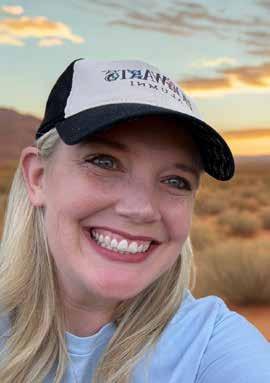

lent costumes,” Ichimura said. “We want Halloween to be a fun time for everyone.”
Like other principals, Ichimura emphasized classroom learning.
“We encourage staff to plan learning activities, and they can be ideas linked to Halloween like stories or math so it can be a creative, fun approach to learning,” he said.
In Murray School District, individual schools set safety guidelines.
“Halloween is a fun and exciting time for our students, and we support school administrators in creating a positive and safe environment by developing traditions and practices unique to their school,” said Doug Perry, Murray District’s communication officer. “We also encourage families and the community to prioritize safety when choosing how to celebrate, both at school and beyond.” l



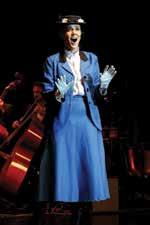
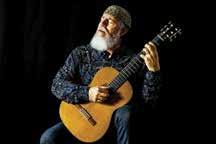


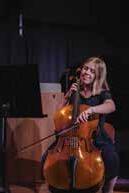


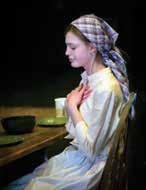







Halloween parades, like this one at Sandy Elementary in 2023, are fun for students and the community, but safety is an important factor, principals say. (Julie Slama/City Journals)
Parents resist proposed shutdown of Eastwood Elementary School

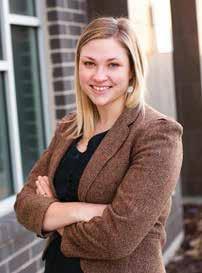
By Lizzie Walje l.walje@mycityjournals.com
Families and parents are speaking up after learning that Granite School District is contemplating closing down Eastwood Elementary School. Eastwood, located on 3305 S. Wasatch Blvd. in Millcreek, has solidified itself as a community mainstay, serving thousands of students for more than 60 years. Now, its future is in jeopardy.
The District has been having conversations regarding Eastwood’s future since earlier in the year. However, now that school is back in session, and District population studies were conducted over the summer, these conversations are coming to a head and decisions hang in the balance.
Despite being Utah’s largest and most populous school district, Granite has been suffering from declining enrollment, a trend which has worsened in recent years, particularly post Covid-19 pandemic. They have cited monetary issues as their biggest incentive for recent closures, many of which targeted elementary and middle schools.
In 2022, Granite School District received similar push back from parents. At the time, they were contemplating shutting down Mill Creek, Spring Lane and Twin Peaks elementary schools. The school board eventually voted to shut them down, claiming District funds could be better allocated
elsewhere, and the students better served at different institutions.
This decision led to vocal opposition from various parents who protested the closures for a handful of reasons. At the time, the aforementioned schools served relatively diverse student populations, with Twin Peaks housing a student body that was 43% Latino and Spring Lane serving a student body where 43% of students were POC.
Parents argued these schools were important to the community based on their inherent value to minority populations. At the time, April Flores, then-president of the Mill Creek Elementary PTA, gave an impassioned speech calling for reconsideration.
“Representation matters,” Flores proclaimed. “It matters in the classrooms. And it matters at the administrative level.”
Fast forward three years later and parents at Eastwood are presenting arguments that are also anchored in community values and importance. In an email to City Journals, Eastwood parent Alyssa Peterson argued that “Eastwood has been a cornerstone school to the eastside of Millcreek for more than 60 years. It is a Gold STEM school and every year ranks in the top 10 elementary schools in Utah based on student performance.”
Eastwood is one of several schools that are currently being evaluated for potential closures by the District. Through years of conversations and debates regarding closures, the District has consistently claimed that tight resources paired with declining enrollment have made it difficult to justify the operation of various schools. They have continually maintained that these closures, while
challenging, are ultimately beneficial for the community, and most importantly, the students.
Andrea Stringham, spokesperson for Granite School District, has also said that the population studies used to help inform the District’s decisions, are often backed by many faculty and families in the areas they focus on.
“[Members of the community] advocated to have this area studied, because they’re living it every day — of how strained their resources are and how burnt out the teachers are,” Stringham said.
Despite Stringham’s reasoning, many parents and families still see the value in Eastwood, both academically and at a community level. Moreover, many adversaries of the closure argue that Granite needs to uphold its promise, as the 2017 Bond presented by the District promised to rebuild Eastwood.
“Closing [Eastwood] would break trust with families, disrupt hundreds of students, and erase decades of community investment,” says a Change.org petition urging signers to help stop the closure of Eastwood. As of early September, the petition had 624 verified signatures.
The decision of whether Eastwood will stay open will be made in December, when the board puts the proposition to a vote. For now, those protesting the closure are urging community members to sign the Change.org petition, in addition to inviting community members to attend discussions, leading up to the vote. l
After serving the community for over six decades, Eastwood Elementary School could close down, much to the dismay of many parents and community members. (Granite School District)
Preparedness conference readies community members for emergencies
The free event provides tools for safety, resources and resilience.
By Peri Kinder peri.k@thecityjournals.com
No one wants to face an emergency, but being prepared can mean the difference between safety and chaos. At the first Fall Preparedness Conference on Saturday, Oct. 25, Utah residents can learn how to prepare for earthquakes, wildfires, floods, power outages and medical emergencies at the South Salt Lake Community Center (2531 S. 400 East).
The free event is open to all community members, bringing together resources, agencies, experts and demonstrations to help families, groups or individuals build skills, acquire confidence and learn how to prepare for the unexpected. Emergency preparedness experts have stated that a communication plan, basic skills and an adequate supply of food and water can save lives during dangerous situations.
Held in conjunction with SSL, Salt Lake City, Millcreek, Holladay, Murray and Cottonwood Heights, the Fall Preparedness Conference is about building resilience and knowledge.
“We want to make sure people are hearing about this and feel welcome to join us,” said SSL Emergency Management Coordinator Yasmin Abbyad. “If people have any questions, whether it’s about how they can be better prepared, how they can prepare their homes and what they should do in terms of insurance, we will be able to answer those questions.”
The morning event will feature breakout sessions that include Hands-on Stop the Bleed training; a CERT skills station to practice triage, cribbing, carrying and fire extinguisher
use; a moulage demonstration to learn how to apply realistic, mock injuries; and the HAM It Up radio essentials course for understanding ham radio operations.
“We have a lot of people in our community who have gotten a ham radio license, but they don’t necessarily know how to use their radio, or don’t know how to get connected to the community,” Abbyad said. “We have five or six different groups that will be present at the conference, where people can ask questions to experts in the field.”
The afternoon is dedicated to a full disaster simulation where community members can practice skills they learned in the CERT course. People who haven’t earned a CERT certification can shadow the members or watch from the sidelines to learn necessary disaster actions.
For decades, Utah officials have encouraged residents to prepare for disaster. Abbyad mentioned the recent fire in Millcreek, caused by a lawn mower, that left 80 people without a home. She also pointed out the predicted earthquake in Utah, which could cause major damage and injuries.
“If the big earthquake hits us, it could take up to four days for outside resources to get to us. Highways might be down, electrical lines and trees are likely going to be in the streets and all of that has to be cleared before they can make their way to hospitals or extremely damaged areas,” Abbyad said. “We want to make sure people are prepared with water and the ability to survive for four or five days without the amenities we’re used to having.”
Although the event is free, pre-registration is appreciated so organizers have an estimated number of attendees. Visit SSLC.gov or email yabbyad@sslc.gov for registration information. l

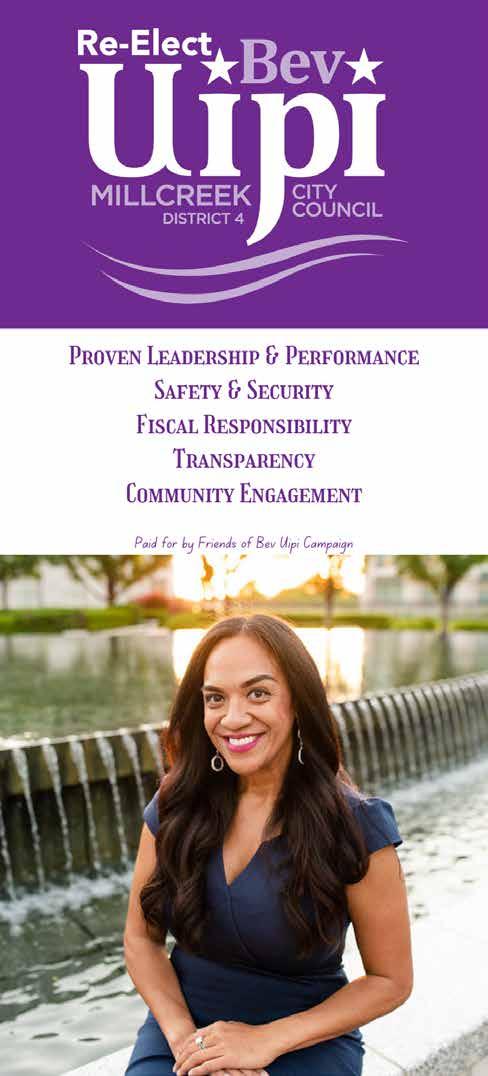
The Fall Preparedness Conference on Saturday, Oct. 25, will help groups, businesses, families and individuals get ready for an emergency. (Adobe stock)
Days for Girls provides the gift of opportunity
Volunteers craft menstrual care kits to help girls stay in school and live with dignity.
By Peri Kinder peri.k@thecityjournals.com
more than 500 million women and girls around the world, access to menstrual products is nonexistent. The term “period poverty” describes the struggle faced by people who don’t have adequate menstrual supplies and education.
Days for Girls is a global nonprofit offering dignity and health to women and girls by providing sustainable menstrual kits. Volunteers around the world sew, assemble and distribute the kits, allowing girls to stay in school, attend work and alleviate health concerns that arise when menstrual products are unavailable.
Suzanne Walker runs the Midvale chapter of Days for Girls, along with her friend Jennifer Woods and lots of volunteers. The chapter has created and distributed nearly 2,000 kits to Thailand, Mexico, Vietnam, Fiji, Morocco, Zimbabwe, Peru, Cambodia and Nepal.
“We not only sew components, we are also a source of outreach for our community,” Walker said. “We advocate on behalf of Days for Girls International, teaching about its mission and the reasons why there is a need for such an organization to exist. We also conduct
work events with local churches and business groups, in which they help create the kits that will then be distributed throughout the world.”
Days for Girls was started in 2008 by Celeste Mergens. She was working at a Kenyan orphanage and found that menstruating girls would sit on pieces of cardboard, often going without food. With cultural taboos around menstruation, some women and girls can’t attend school or work, or even go into a kitchen while on their period.
Mergens created washable, long-lasting pads and underwear, designed to last several years, giving the girls the freedom to leave their rooms, reclaim their dignity and potentially end the cycle of poverty.
“The evolution of this pattern for these kits has changed many times,” Woods said. “They keep making it better and better. They listen to the girls and the moms, and the feedback that people give, and they fix any issues.”
The kits contain two pairs of underwear, two reusable shields, eight absorbent liners, a washcloth and soap for cleaning, and a waterproof bag to hold everything. Colorful fabrics help normalize menstruation and the components dry quickly to allow the women and girls to manage their hygiene. The waterproof bags are also used as a washing device in places where water is scarce.
“Some girls and women walk miles and miles for water,” Woods said. “They have this very small amount of water to use for their


cooking and their cleaning, so these bags become little washing machines.”
Walker said it’s a lot of work to create the kits and they have specific instructions to follow to ensure the pieces work together. But she calls it a “labor of love” for the thousands of women and girls their kits have helped over the years. The group holds service projects several times a year, where volunteers sew kit components.
“Even in the United States, there are women who don’t have access to period prod-

ucts,” Walker said. “There are hundreds of stories of lives being changed through Days for Girls. I love going into my community and talking about it, because we don’t talk about it. I talk to a lot of young women’s groups and they are super embarrassed, but they have no idea how lucky they are.”
To learn about volunteering or donating to the Days for Girls Midvale chapter, visit the Facebook page @dfgmidvale. For information about the international organization, visit DaysForGirls.org. l

Did you know Driveology could save you an average of 25% on your auto insurance premium? Savings start immediately after you enroll, earning a 10 percent discount just for signing up. Contact me today to learn more about saving with Driveology®.





Millions of women and girls have received menstrual kits from Days for Girls. The Midvale chapter has created and distributed thousands of kits to girls all over the world. (Photo courtesy of Suzanne Walker)
2025 GENERAL ELECTION VOTER GUIDE
MILLCREEK VOTING INFORMATION SALT LAKE COUNTY VOTING INFORMATION
In Millcreek, four candidates are campaigning for a seat on the city council. You’ll learn more about each of them as you continue to flip through this Voter Guide.
• Angie Gray & Thom Desirant are running for District 2
• Connor Gale & Bev Uipi are running for the District 4 council seat.
Voters are encouraged to locate their most convenient ballot drop box and review the city’s updates about Ranked Choice Voting (RCV).
Drop box - The ballot drop box within Millcreek Common (1354 E. Chambers Ave.) can be located to the north end of the property - between City Hall (1330 E. Chambers Ave.) and the Granite Credit Union Adventure Hub (3675 S. 900 East).
To RCV or Not To RCV - Even though Millcreek did opt into utilizing a Ranked Choice Voting (RCV) process (through the Municipal Alternate Voting Methods Pilot Project), it will not be required this election cycle due to the limited number of candidates that declared (only two filed for each district race).
Voters will only be able to vote for one candidate. Millcreek residents will receive a regular election ballot this year instead of a RCV ballot. This may be a change for some voters as RCV ballots were counted in both the 2021 and 2023 election cycles.

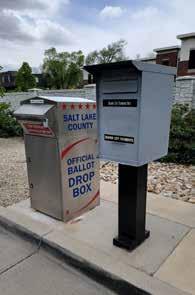
Hey Voters! Please review the following voting information directly from Salt Lake County before submitting your ballot.
Nov. 4 is the General Election - Vote Centers and drop boxes will close promptly at 8:00 p.m.
Important Dates
Oct. 10 - Salt Lake County will host Logic & Accuracy Tests where the public is invited to attend live demonstrations of voting equipment.
Oct. 14 - Ballots being to be mailed (21 days before the election as per Utah’s legislation).
Nov. 18 - Board of Canvassers Meeting where each city will certify results after presented to the City Recorders.
Vote Box locations:
Residents can vote by mail or in-person at various drop box locations throughout Salt Lake County:
County - Salt Lake County Government Center (2001 State St.)
Cottonwood Heights - City Hall (2277 Bengal Blvd.)
Draper - City Hall (1020 Pioneer Rd.)
Holladay - City Hall (4280 S. 2300 E.)
Herriman - City Hall (5355 Main St.)
Midvale - City Hall (7505 Holden St.)
Millcreek - Common (1354 E. Chambers Ave.)
Murray - Post Office (5025 State St.)
Sandy - City Hall (1000 Centennial Pkwy.)
Sandy - Senior Center (9310 S 1300 E)
South Jordan - City Hall (1600 W Towne Center Dr.)
South Salt Lake - Granite Library (331 S. 500 E.)
Riverton - City Hall (12830 S Redwood Rd.)
Taylorsville - City Hall (2600 W Taylorsville Blvd.)
Wet Jordan - City Hall (8000 S Redwood Rd.)
West Jordan - Ron Wood Park (6000 W New Bingham Hwy.)
West Valley - City Hall (3600 S Constitution Blvd.)
Register to Vote:

Residents can register to vote online up to 11 calendar days before the election (before 5pm). Registration must be submitted and received before Tuesday, Oct. 28 to receive a ballot in the mail. A valid form of ID, accurate address information, and date of birth is required to register. Residents can register either: online by visiting the State of Utah’s website (see adjacent QR code); through mail by filling out the Formulario de Inscripcion por Correspondencia Para Votantes (Voter Mail-In Registration Form) found on the County’s website; or in-person at the 2001 S. State St. office. Same-Day registration options will also be available at vote centers. Learn more about voting information through Salt Lake County’s website at: saltlakecounty.gov/clerk/elections. Or by directly emailing: vote@saltlakecounty.gov.
MILLCREEK DISTRICT 2
QUESTIONS THOM DESIRANT
Sourced directly from our readers

Do you believe current property tax revenue is being used effectively? How so?
Thinking about fiscal responsibility—what values should your local budget reflect? How do you plan to balance those values?
Absolutely. In Millcreek, every penny of property tax goes directly to public safety (police and animal control). We haven’t raised property taxes in two years, and when we did increase them previously, it was only to cover mandated costs when the state forced Unified Police to separate from the County Sheriff. I’m always open to community input on how we spend your money. We need to stay mindful of families and seniors on fixed incomes while making sure our neighborhoods stay safe.
Our budget should prioritize safety, stability, and sustainability so we can keep people safe, maintain reliable services, and build infrastructure that lasts. We’ve proven this works in Millcreek. We’ve balanced our budget every year, built one of the state’s largest emergency funds, and still invested in roads, parks, and trails. The key is focusing on essentials first, then using grants and outside funding to stretch local dollars further. Many of our major projects get funded through county, state, and federal grants, which lets us accomplish more without burdening taxpayers. Smart budgeting means long-term thinking and creative funding solutions.

ANGIE GRAY
angieformillcreek.com
Reason for running:
Provide authentic local representation for local government. I am a third-generation resident of Millcreek, and I’ve lived in District 2 for the last 15 years. I’m a registered nurse, a mom/wife, and an active volunteer. I’ve always been invested in Millcreek and offer true representation from someone in the trenches!
Quick bio:
I am an active Millcreek & Salt Lake City volunteer. On the Healthy Millcreek Coalition I help advocate ‘health in all policies’ and currently focus on youth mental health. I work on large-scale planning as a CERT member (Community Emergency Response Team), and I support arts and diversity through the Interfaith Harmony event planning. My kids and I have spent six summers as docents at This is the Place Heritage Park, hoping to honor Utah heritage & history.
Schools in Millcreek are an area of critical importance right now. The evolving landscape impacts us all. I’ve spent 8+ years volunteering extensively in our schools, including through Millcreek Elementary’s closure. I’ve also taught Nurse Assisting for Granite School District, and private Spanish classes. I see many perspectives and bring proven leadership amidst complex change. I know schools.
What systems would you support to hold local officials accountable when transparency standards aren’t met?
What is your stance on local government cooperation with ICE?
We prioritize transparency in Millcreek. Residents can sign up for weekly emails about city business and meeting agendas, and we send residents a monthly newsletter with detailed updates. We also just launched a text program, just send “Hi” to 801-217-9811 to report problems or ask for information. I support independent audits, accessible public records, and strict open-meeting compliance. When standards aren’t met, there should be real consequences through public disclosure, corrective action, or ethics reviews. People deserve to see how decisions get made and how their money gets spent. I’ll keep working to make that information easy to find and understand.
I’m opposed. Local police should focus on community safety, not immigration enforcement. Unified Police already has a policy against cooperating with ICE, and I fully support that. Everyone in Millcreek should feel safe calling police, reporting crimes, and using city services without fear of being targeted over immigration status. When people trust local government, our whole community is safer. Millcreek has led the state in ensuring the federal government respects the rights of Millcreekers. We stepped up when ICE illegally tried to arrest a legal resident for honking at them, and we have worked to help lawful refugees stay in their homes.
My nursing career has taught me advocacy skills and empathy. I have worked closely with elderly, immigrant, and homeless populations, in all types of care settings–from county clinics to federal hospitals to private concierge wellness practice. Two formative jobs I had prior to becoming an RN were working at Salt Lake City’s The Road Home shelter, and working with Spanish immigrants in LA county. I care about vulnerable populations and understand the factors that influence wellbeing. A holistic approach to community increases longevity and quality of life for everyone.
PRIORITIES:
• Strengthen schools
• Promote healthy living
• Balance development Improve infrastructure
• Maintain a balanced budget
Stay informed about my campaign: www.angieformillcreek.com
MILLCREEK DISTRICT 4
QUESTIONS
Sourced directly from our readers

Do you believe current property tax revenue is being used effectively? How so?
Thinking about fiscal responsibility—what values should your local budget reflect? How do you plan to balance those values?
CONNOR JETT GALE
voteconnorgale.com
I am concerned if we are using our funds in an effective way to help our citizens. When our neighborhood’s infrastructure isn’t up to the standards they should be, something isn’t working. I also believe that we should consult the public and should seek more input from Millcreek’s citizens and see where our constituents want their taxes to be spent.
Fiscal responsibility is making responsible and thoughtful choices that improve daily life and stretch every dollar so that the community can feel the benefits.
Our local budget should reflect the needs of our citizens, and we should prioritize our funds where they are needed most. That to me looks like a focus on our neighborhood infrastructure, then our local amenities, with a final priority on sustainable growth. Our infrastructure should first be both reliable and safe, then we need to maintain our open spaces, and create ease of access for our residents so everyone has a place to go. Only then can we start to look into sustainable and responsible growth. If elected, I would advocate for clear priorities, involve residents in decision-making, and seek out processes that could be improved to deliver better results.

BEV UIPI
Bev2Millcreek.com
All of Millcreek’s property tax revenue is allocated to support the Millcreek Unified Police Department. As the City Council, we consider this an effective use of funds because ensuring public safety is our top priority. This allocation is also clearly outlined in the annual property tax notice, providing transparency for our residents.
A fiscally responsible budget should reflect values like balance, transparency, long-term planning and smart resource management. In Millcreek, we ensure our expenditures never exceed revenues. Our priorities include infrastructure needs such as streets, sidewalks, storm drains, flood zones and development. When we became a city nine years ago, we inherited over 20 years of requests from Salt Lake County. Each year, we tackle what’s feasible within our budget…Sales tax makes up 46% of our revenue, so we encourage residents to shop locally to support our community. We base long-term planning on risk, safety, and available resources. Transparency is central to our approach: we communicate through Truth in Taxation hearings, open budget amendments in City Council meetings, our weekly e-newsletter, the Millcreek print newsletter, and direct conversations with residents. We believe strong communication is essential to good governance—and we’re always working to improve it.
What systems would you support to hold local officials accountable when transparency standards aren’t met?
Residents have made it clear that transparency and accountability are top priorities, and I agree. Millcreek has many programs to help promote transparency including access to public records and meetings, access to budgets-in-brief and government records access.
I believe we need to create a widespread effort to make communication with local governments easier. This means creating more avenues of communication between the public and the council outside of contacting them directly. I believe we should do surveys before deciding on impactful decisions to get ideas from the public. We could also post online, the Millcreek newsletter, or do flyers out to the community the week before the council takes public comment and votes on these decisions so that anyone who isn’t aware has ample opportunity to become informed and give their opinion.
Transparency is essential to earning and keeping public trust. I believe we have strong standards in place through statute and ordinance. However, when those standards aren’t met. I support systems that hold local officials accountable through clear oversight and public access. Currently, we conduct annual third-party audits, require public reporting of budget amendments and contracts, and offer a formal complaint process. Residents can also request records through GRAMA to ensure timely review and response.
I support our open data tools that allow residents to track spending and infrastructure projects in real time on the Millcreek website. Regular town halls, listening sessions, and accessible communication—like our weekly e-newsletter and open City Council meetings—help ensure officials stay responsive and residents stay informed. Millcreek has made strong progress with Truth in Taxation hearings and public budget amendments. Accountability isn’t just about fixing problems—it’s about preventing them through transparency, communication, and community involvement.
What is your stance on local government cooperation with ICE?
My stance is simple. Local government should focus on public safety and not immigration enforcement. Every person in our community should feel safe calling the police, going to school, reporting problems, or using city service. NO ONE should fear coming forward because of their immigration status. I will prioritize policies that protect residents and build trust.
I believe public safety must be rooted in trust, transparency, and equal protection for all residents—regardless of immigration status. Cooperation with ICE should be limited to serious criminal cases, not civil immigration enforcement… Millcreek’s diverse community includes refugees, ethnic minorities, and non-traditional families. To ensure everyone feels safe engaging with law enforcement, we must maintain clear boundaries between local policing and federal immigration actions. I support policies that prioritize community safety while respecting individual rights and dignity.
Millcreek nurse makes wickedly good treats on Food Network’s Halloween Baking Championship
Local baker uses plenty of imagination to whip up haunting desserts.
By Peri Kinder peri.k@thecityjournals.com
Melanie
Bjork-Jensen has a tattoo that reads, “I am worth the effort it takes to be happy.” That motto was put to the test when she was selected to be a contestant on the 11th season of Food Network’s Halloween Baking Championship.
The West Jordan resident was one of 10 bakers from around the country who competed on the seven-episode show, vying for the chance to win $25,000. Set in a haunted mansion, the Halloween Baking Championship created terrifying competitions for the contestants. The first baking test challenged bakers to depict their number one Halloween fright, and make it pump blood.
“We were given tubing and a pump, and we had to make the blood edible and match the flavor of our creation and be able to slide the tubing through without messing up the dessert,” she said. “We had to do it live on camera, in front of the judges, and it was so terrifying.”
Bjork-Jensen taught herself to bake by watching YouTube videos. She began making wedding cakes, built up a clientele and used the money she earned to pay her way through nursing school. She worked as a trauma nurse before becoming a traveling labor-and-delivery nurse, currently working at St. Mark’s Hospital in Millcreek.
This was her second time applying for the Halloween Baking Championship. This year, Bjork-Jensen was contacted by the
show’s producers to see if she was still interested. She was definitely still interested.
Filming the show was intense. Bjork-Jensen said she felt trauma-bonded to the other contestants, whom she loved getting to know, and even had a well-publicized meltdown on set during one of the challenges.
“I have a background as an emergency nurse, but I feel like [the show] brought me to the breaking point,” she said. “It was also an amazing experience. It was fun and unlike anything I’d done before.”
Bjork-Jensen survived a brain tumor four years ago, but it left her with Hashimoto’s, an autoimmune disease that affects the thyroid gland. The disease is exacerbated by gluten, so baking on the show became a challenge because she couldn’t taste the items she was making.
In one episode, she knew her recipe was wrong, but she wasn’t sure what she’d missed. She decided to take a bite, then spit it out to see if she could pinpoint her mistake.
“I had left the sugar out. It was terrible.”
Bjork-Jensen said her two children have been her biggest cheerleaders. They were able to fly to California on a day she wasn’t filming to hang out and they’ve told all their school friends about her baking skills.
Although she compared the experience to “water torture,” she found value in the effort and the time she took off work to do something important. She permitted herself to enjoy the experience, acknowledging that it was okay to do something for herself.
“I tend to be unkind to myself and I haven’t been very pa-

tient with myself, like allowing myself to learn new things. So being able to give myself the right to do poorly and learn and to do better shows I’m worth the effort,” she said. “Going through this felt like the biggest piece of therapy that I could have, and it was an incredible life-changing experience.”
Season 11 of Food Network’s Halloween Baking Championship premiered on Sept. 15 and is currently available on Food Network and streaming services. l
Chalk the Walk brings color to the community
Dozens of entries covered the plaza at the Viridian Event Center.
By Peri Kinder peri.k@thecityjournals.com
Chalk the Walk transformed the Viridian Event Center’s outdoor plaza into a vibrant gallery with nearly 60 chalk art entries. On Aug. 30, artists of all ages and abilities gathered at the center, spending hours creating their displays.
“It’s a chance for the community to come together and see some art and we have a bunch of different age categories, from youth all the way up to adult,” Sarin Wesel said, Viridian’s event coordinator. “It’s an opportunity for people to try chalk art in a low-stakes environment and have fun with it.”
In partnership with West Jordan City, the Viridian Event Center created the free Chalk the Walk event and provided materials for all entrants. Displays made by artists under 12 were not judged; instead, the youth were given the chance to try out the medium, stretch their abilities and learn from more experienced artists.
Everleigh Curran, 15, is a Millcreek chalk artist. She participated in last year’s Chalk the Walk event and found she had a
real skill for it. She said her tribute to “The Cat in the Hat” was simpler than other designs she’d created, but she loved the characters.
“I also am an artist, so I like drawing and I like using stuff that I can blend. So, that’s what got me interested in this,” Everleigh said.
Community members were invited to add their own chalk design to the wall around the plaza while enjoying the dozens of chalk art entries.
After all the votes were counted, Trisha Bhatia won the People’s Choice award; Nichole Kleinman took first in the Adult Solo category; Lexie Daley and Tee Jorgensen won the Adult Team division; Drako Woodland finished first in Teen Solo; Sophie Brewer and Sarah Hooper took the top prize for Teen Team; and Carl Brewer, Tesla Brewer and Atlas Brewer finished first in the All Ages category.
“We have some regulars that come every year and are part of the chalk community, so everyone gets a chance to meet new people,” Wesel said. “It draws people into that community and we were able to draw in some of the library patrons. They came to the library and they saw something going on, and they came and got to participate in the community activity.” l

“The Cat in the Hat” took center stage in Everleigh Curran’s chalk art entry. (Peri Kinder/City Journals)
Melanie Bjork-Jensen, a West Jordan wedding cake baker and labor-and-delivery nurse, competes on season 11 of Food Network’s Halloween Baking Championship. (Photo courtesy Food Network)
Senior show demonstrates the art of aging brilliantly
The exhibit honored the beauty of experience and lifelong expression.
By Peri Kinder peri.k@thecityjournals.com
Abrokenswing hangs from a tree branch, next to an empty house depicted in colors of brown and gray. The picture is titled “Where Have All the Children Gone?” and was painted in watercolor by Millcreek resident Ralph Morelli to depict the loneliness he felt when he didn’t visit with his children and grandchildren.
Morelli’s painting was one of more than 200 entries in the third annual Senior Art Show, sponsored by Salt Lake County Aging Services. Held at the Salt Lake County Government Center (2001 S. State St.), the display featured art in every medium, created by seniors aged 60 and up from around the county.
“Art allows us to express feelings that we might otherwise not be able to give verbally and that’s why I believe it’s so important,” Morelli said. “My art is called emotionalism, because I’m not going for realism. I can express myself with just a few brush strokes. That’s why I think art is important. It allows us to tap into that inner self.”
The show included displays of pottery, watercolor paintings, sculpture, needlework, quilts, oils and acrylic paintings, photogra-
phy and carvings. Many of the works were done at county senior center locations.
Afton January works with the county’s aging services program. She said the pop-up gallery is a fun way to bring exposure to artwork created by the state’s seniors and give them a chance to show off their talents. Last year’s event had fewer than 90 entries, but the 2025 show had more than double that number.
“It’s frankly a smashing success this year. The skill level is off the charts,” January said. “It’s one of those events that’s been gaining momentum, because it’s a fun opportunity for folks, especially our senior center participants, who represent most of the artists here, to take what they do at those centers and bring it into the community in a way that really feels intergenerational and community spirited. And it’s a fun opportunity for our older adults.”
Millcreek resident Eve Cole entered several artworks at the show, including a drop-pour painted vase and picture, and a framed arrangement of dried flowers. Cole said her sister-in-law got her interested in art during COVID, so they FaceTimed together while creating fun art pieces.
Her painting, “Black Bird in Flight,” was made with a drop-pour background, accented with black and white.
“I showed it to my husband and he said, ‘It’s birds flying.’ I never even would have

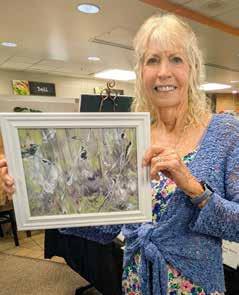
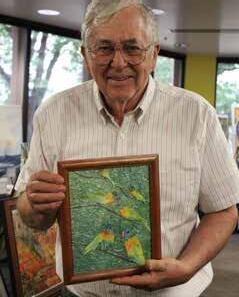
thought of that,” Cole said. “It’s just so rewarding. It just makes me happy.”
More than 300 visitors at the art show voted on their top three favorite entries. The Director’s Choice winner was Dewey Hansen (River’s Bend Senior Center) and the top three vote recipients were Deborah Chiquito (Riverton Senior Center), Shu Yamamoto (Taylorsville Senior Center) and Margi G Owens (Kearns Senior Center).

“Our older adults, many of whom are retired, get to showcase their work and feel like they’re a part of something big and public,” January said. “It gives them some recognition.” l







The Director’s Choice winner of the Salt Lake County Senior Art Show was Dewey Hansen, a regular attendee at the River’s Bend Senior Center in Salt Lake City. (Photo courtesy of SLCounty)
Eve Cole holds her art show entry, “Black Bird in Flight.” The Millcreek resident started painting during COVID. (Peri Kinder/City Journals)
The Power of Human Connection in Salt Lake County
Utahis in a paradox. We are known as one of the most social states in the nation, yet our residents also report some of the highest feelings of loneliness. State health surveys show that nearly one in four Utah teens in 2023 and about 6% of adults in 2021 said they often or always felt, “People are around me but not with me.” That’s a sobering reminder that being surrounded by people is not the same as feeling connected to them.
The U.S. Surgeon General defines loneliness as the distress of not having adequate meaningful connections, while social isolation is the objective lack of social roles, relationships or interaction. Both are harmful. Loneliness raises the risk of premature death by 26%, and social isolation by 29%. Utah data show youth are particularly vulnerable, with loneliness peaking around 10th grade. At the other end of life, older adults may report less loneliness, but many live alone or are less socially active, leaving them isolated—and at increased health risk— even if they say they feel fine.
It’s not all bad news. Among adults, reported loneliness has risen from 5% in

2019 to 16% in 2024. While that increase seems alarming, some experts believe it reflects growing awareness. More people are recognizing that connection matters, which may encourage them to seek help or create new relationships. Meanwhile, Utah’s highest years for suicides (2017) and overdose deaths (2022) are behind us, with rates trending slightly down. We should not ignore loneliness, but perhaps our awareness is a hopeful step toward stronger, healthier communities.
and one-on-one time give youth safe spaces to share what they’re really experiencing.
Schools and businesses also play a role. Policies that encourage real connection—team projects, buddy systems, carpools, phone-free zones or mentoring programs—help students and employees build relationships that strengthen both well-being and performance. Identifying at-risk youth early and linking them with mentors can make a world of difference.
a meal or volunteering at church, these experiences weave the fabric of community life. With creativity, we can support system-level changes that expand these opportunities in healthy ways.



Addressing loneliness requires all of us. Parents can set the stage at home by turning off screens, setting aside phones, listening closely, and modeling the conversations they hope their children will have with others. Simple family meals



Local governments can create environments where connection naturally happens. Parks, libraries, recreation centers and public transportation all serve as “third spaces” where neighbors can meet. Programs like Salt Lake County’s Free Youth Rec Passes, summer events, farmers markets and free-fare zones lower barriers and invite people to gather. These aren’t just amenities; they are investments in the health and strength of our community.
Faith groups, sports teams and even traditions around food and gathering offer additional pathways. Whether it’s cheering together in the stands, sharing
In the end, the responsibility rests with each of us. Teens can choose to include someone sitting alone. Adults can prioritize friendships, check in on a neighbor or carve out time for family. Older adults can accept invitations or invite others into their routines. Each of these choices is small, but collectively they build the kind of community Salt Lake County is known for—caring, connected and resilient.
So I encourage you to pause and ask yourself: Am I truly connecting or just surrounded? Whether you are a student, a parent, a business leader or a retiree, you have the power to strengthen the web of relationships that hold us all together. In Salt Lake County, our greatest strength doesn’t come from policies or programs alone—it comes from people. When we choose connection, we choose health, hope and a brighter future for our community.



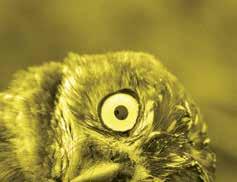


























Life and Laughter - Magic is a Superpower
Back in the day, it didn’t take much to be labeled a witch. Did you own a cat? Witch. Did you have a birthmark? Witch. Did you use herbs, wear a cape, know how to read or lure children into your gingerbread-flavored home so you could eat them for dinner? Witch.
I’m just saying, the bar was low. Starting in the 1450s, witch hysteria swept across Europe, lasting for centuries. Intense warfare, hardship, famine and disease meant only one thing: it was time to burn the witches, because obviously.
Nearly 60,000 people were tried and killed as witches. More than 80% were women and 60% were over the age of 40. It was a gendercide that wiped out generations of women. Many were healers, midwives, widows and property owners.
They’d reached a time in their lives where they were fine being alone, with maybe a cat or two. They just wanted a nice broom, a boiling cauldron of soup and a Pinterest board of “Witchy Reads.”
Many women step into their power once they hit 40, but give women power and there’s going to be trouble. Killing the older generations meant wisdom was lost forever, which is probably why we have mini golf sets for the toilet.
Like Labubu and Meta (and just as

diabolical), witch trials were big business. Women were arrested, property was seized and people flocked to churches because no one wants to accidentally sell their soul to Beelzebub.
The witch trials also created a disconnection between women; a fear of gathering, the angst of being seen as a “coven” when all you wanted to do was watch the “Real Housewives of Salem.” Women stopped socializing because having a friend for tea could end in a hanging. (And you thought your book club was stressful.)
I’m a lover of all things witchy, a devotee of strong women using their magic for good. A witch is a woman who speaks truth to power, without shame. Imagine a combination of Dolly Parton, Oprah Winfrey and Ruth Bader Ginsburg, a woman so powerful even the Puritans would have been like, “Nope, not today.”
You see, a witch hunt creates a cul-
ture that undervalues women. When you describe women as shrill, chatty, feisty, mousey, sassy, emotional, slutty, hysterical, irrational or hormonal, those words strip away power.
How many of these words are used to describe men? Almost zero. At the worst, men get labeled as “grumpy,” and somehow that becomes “distinguished.”
There’s still a witch hunt going on today. Saying “women’s rights” to certain groups triggers frothing at the mouth and a call for the ducking stool.
Women want to be believed, heard and have the ability to live without violence or discrimination. We want affordable physical and mental health care, an equal wage and respect. Is that insane, deranged, unhinged or any other word used to lock women up in asylums, as recently as 1967?
A witch stands on her own. She embraces her age, her knowledge and her intuition, without fear. It’s not surprising that interest in witchy practices is rising. You can learn spells on TikTok, craft a voodoo doll on YouTube and banish your ex to the depths of Detroit using a candle, cayenne pepper and a squeeze of lemon. Science, obviously.
For women who have felt disenfranchised in their communities, religions and

workplaces, witchy practices are a way to find their power. It isn’t an excuse to turn women into barbecue.
I associate magic with creation, and women are the ultimate creators. Women are magic, able to run empires, sing lullabies and look fabulous in a cape. Do you need someone to change the world for the better? Find a witch.








